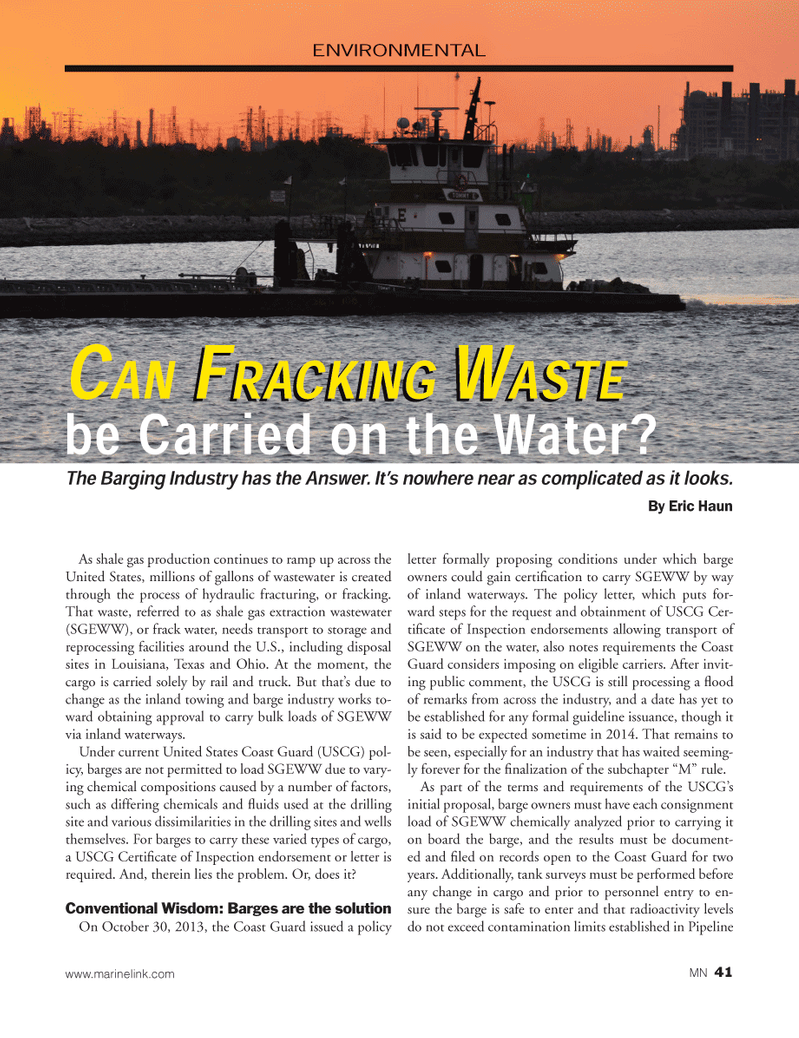
Page 41: of Marine News Magazine (February 2014)
Combat & Patrol Craft Annual
Read this page in Pdf, Flash or Html5 edition of February 2014 Marine News Magazine
ENVIRONMENTAL As shale gas production continues to ramp up across the United States, millions of gallons of wastewater is created through the process of hydraulic fracturing, or fracking. That waste, referred to as shale gas extraction wastewater (SGEWW), or frack water, needs transport to storage and reprocessing facilities around the U.S., including disposal sites in Louisiana, Texas and Ohio. At the moment, the cargo is carried solely by rail and truck. But that?s due to change as the inland towing and barge industry works to- ward obtaining approval to carry bulk loads of SGEWW via inland waterways. Under current United States Coast Guard (USCG) pol- icy, barges are not permitted to load SGEWW due to vary- ing chemical compositions caused by a number of factors, such as differing chemicals and uids used at the drilling site and various dissimilarities in the drilling sites and wells themselves. For barges to carry these varied types of cargo, a USCG Certi cate of Inspection endorsement or letter is required. And, therein lies the problem. Or, does it? Conventional Wisdom: Barges are the solution On October 30, 2013, the Coast Guard issued a policy letter formally proposing conditions under which barge owners could gain certi cation to carry SGEWW by way of inland waterways. The policy letter, which puts for- ward steps for the request and obtainment of USCG Cer- ti cate of Inspection endorsements allowing transport of SGEWW on the water, also notes requirements the Coast Guard considers imposing on eligible carriers. After invit- ing public comment, the USCG is still processing a ood of remarks from across the industry, and a date has yet to be established for any formal guideline issuance, though it is said to be expected sometime in 2014. That remains to be seen, especially for an industry that has waited seeming- ly forever for the nalization of the subchapter ?M? rule. As part of the terms and requirements of the USCG?s initial proposal, barge owners must have each consignment load of SGEWW chemically analyzed prior to carrying it on board the barge, and the results must be document- ed and led on records open to the Coast Guard for two years. Additionally, tank surveys must be performed before any change in cargo and prior to personnel entry to en- sure the barge is safe to enter and that radioactivity levels do not exceed contamination limits established in Pipeline FRACKING W ASTE FRACKING WASTECAN F RACKING W ASTE CAN FRACKING WASTE be Carried on the Water? be Carried on the Water? The Barging Industry has the Answer. It?s nowhere near as complicated as it looks. By Eric Haunwww.marinelink.com MN 41MN FEB14 Layout 32-49.indd 41MN FEB14 Layout 32-49.indd 411/20/2014 10:20:33 AM1/20/2014 10:20:33 AM

 40
40

 42
42
